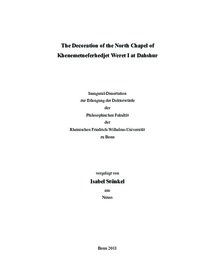Stünkel, Isabel: The Decoration of the North Chapel of Khenemetneferhedjet Weret I at Dahshur. - Bonn, 2018. - Dissertation, Rheinische Friedrich-Wilhelms-Universität Bonn.
Online-Ausgabe in bonndoc: https://nbn-resolving.org/urn:nbn:de:hbz:5-52036
Online-Ausgabe in bonndoc: https://nbn-resolving.org/urn:nbn:de:hbz:5-52036
@phdthesis{handle:20.500.11811/7451,
urn: https://nbn-resolving.org/urn:nbn:de:hbz:5-52036,
author = {{Isabel Stünkel}},
title = {The Decoration of the North Chapel of Khenemetneferhedjet Weret I at Dahshur},
school = {Rheinische Friedrich-Wilhelms-Universität Bonn},
year = 2018,
month = nov,
note = {This study examines the relief fragments found at the north chapel of the king's wife and king's mother Khenemetneferhedjet Weret I. The chapel, part of the pyramid complex of Senwosret III (ca. 1878–1840 BCE) at Dahshur, was demolished in antiquity; no standing walls remain. However, the excavations by The Metropolitan Museum of Art recovered about 1,200 relief fragments from its wall decoration, which presents the best-preserved decoration of a queen's chapel in a Middle Kingdom pyramid complex. Combined with a few significant pieces from other royal women's chapels at Dahshur, the study and analysis of the relief fragments allowed the decoration of each wall of the chapel to be reconstructed. The decorative elements include inscriptions with the queen's titles, depictions of the queen in front of an offering table, offering lists, offering-ritual scenes, piled offerings, offering bearers, and animal-slaughtering scenes. Linen-signs and fragmentary oil names can be assigned to inventory lists, and there is evidence for a building-dedication inscription. Based on the analysis of the reliefs, the architectural details of the entrance can also be reconstructed, as can the shape of the lintel. In addition, observations regarding the construction of the walls and the decorative processes can be made, such as building sequence and the hands of different artists. The question of whether the designation "Khenemetneferhedjet" is a name or title is also investigated, and it is argued to be a name in all Dynasty 12 occurrences. The study of the relief fragments thus contributes to our knowledge of royal women's chapels and also touches upon cultural, historical, and art historical questions.},
url = {https://hdl.handle.net/20.500.11811/7451}
}
urn: https://nbn-resolving.org/urn:nbn:de:hbz:5-52036,
author = {{Isabel Stünkel}},
title = {The Decoration of the North Chapel of Khenemetneferhedjet Weret I at Dahshur},
school = {Rheinische Friedrich-Wilhelms-Universität Bonn},
year = 2018,
month = nov,
note = {This study examines the relief fragments found at the north chapel of the king's wife and king's mother Khenemetneferhedjet Weret I. The chapel, part of the pyramid complex of Senwosret III (ca. 1878–1840 BCE) at Dahshur, was demolished in antiquity; no standing walls remain. However, the excavations by The Metropolitan Museum of Art recovered about 1,200 relief fragments from its wall decoration, which presents the best-preserved decoration of a queen's chapel in a Middle Kingdom pyramid complex. Combined with a few significant pieces from other royal women's chapels at Dahshur, the study and analysis of the relief fragments allowed the decoration of each wall of the chapel to be reconstructed. The decorative elements include inscriptions with the queen's titles, depictions of the queen in front of an offering table, offering lists, offering-ritual scenes, piled offerings, offering bearers, and animal-slaughtering scenes. Linen-signs and fragmentary oil names can be assigned to inventory lists, and there is evidence for a building-dedication inscription. Based on the analysis of the reliefs, the architectural details of the entrance can also be reconstructed, as can the shape of the lintel. In addition, observations regarding the construction of the walls and the decorative processes can be made, such as building sequence and the hands of different artists. The question of whether the designation "Khenemetneferhedjet" is a name or title is also investigated, and it is argued to be a name in all Dynasty 12 occurrences. The study of the relief fragments thus contributes to our knowledge of royal women's chapels and also touches upon cultural, historical, and art historical questions.},
url = {https://hdl.handle.net/20.500.11811/7451}
}






